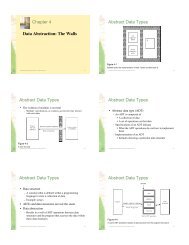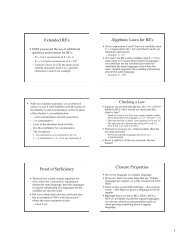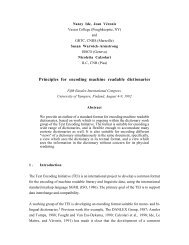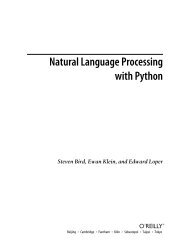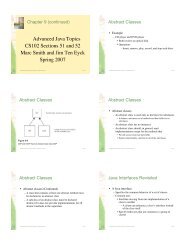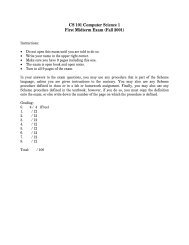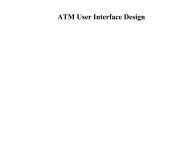From Text to Content: Computational Lexicons and the Semantic Web
From Text to Content: Computational Lexicons and the Semantic Web
From Text to Content: Computational Lexicons and the Semantic Web
You also want an ePaper? Increase the reach of your titles
YUMPU automatically turns print PDFs into web optimized ePapers that Google loves.
Besides, one of <strong>the</strong> most widely used lexical resources,<br />
WordNet (Fellbaum 1998), is also commonly regarded <strong>and</strong><br />
used as an on<strong>to</strong>logy, as fur<strong>the</strong>r evidence of <strong>the</strong><br />
commonalities existing between computational lexicons<br />
<strong>and</strong> on<strong>to</strong>logies (Guarino 1998, Oltramari et al. 2002).<br />
The main argument of this paper is that streng<strong>the</strong>ning<br />
<strong>the</strong> synergies between on<strong>to</strong>logy design <strong>and</strong> computational<br />
lexicon development is a key precondition for <strong>the</strong><br />
<strong>Semantic</strong> <strong>Web</strong> <strong>and</strong> HLT communities <strong>to</strong> truly benefit of<br />
each o<strong>the</strong>r’s results. In particular, we will tackle this issue<br />
by illustrating a series of requirements that computational<br />
lexicons must fulfill in order <strong>to</strong> become effective resources<br />
<strong>to</strong> contribute <strong>to</strong> implement <strong>the</strong> <strong>Semantic</strong> <strong>Web</strong> vision. These<br />
requirements will be discussed in <strong>the</strong> context of an existing<br />
infrastructure for <strong>the</strong> development of semantic language<br />
resources. Moreover, we will also argue for a bidirectional<br />
interaction between computational lexicons <strong>and</strong><br />
<strong>the</strong> <strong>Semantic</strong> <strong>Web</strong>. Not only will computational lexicons<br />
contribute <strong>to</strong> <strong>the</strong> content-based management of information<br />
on <strong>the</strong> <strong>Web</strong>, but <strong>the</strong> emerging st<strong>and</strong>ards for <strong>the</strong> <strong>Semantic</strong><br />
<strong>Web</strong> also provide <strong>the</strong> ground for <strong>the</strong> architecture <strong>and</strong><br />
design of next-generation language resources.<br />
A General Infrastructure for Multilingual<br />
<strong>Computational</strong> <strong>Lexicons</strong><br />
<strong>Computational</strong> lexicons aim at making word content<br />
machine-underst<strong>and</strong>able. That is <strong>to</strong> say, <strong>the</strong>y intend <strong>to</strong><br />
provide an explicit representation of word meaning, so that<br />
it can be directly accessed <strong>and</strong> used by computational<br />
agents, such as a large-coverage parser, a module for<br />
intelligent Information Retrieval or Information Extraction,<br />
etc. In all <strong>the</strong>se cases, semantic information is necessary <strong>to</strong><br />
enhance <strong>the</strong> performance of NLP <strong>to</strong>ols, <strong>and</strong> <strong>to</strong> achieve a<br />
real underst<strong>and</strong>ing of text content. Multilingual<br />
computational lexicons add <strong>to</strong> <strong>the</strong> representation of word<br />
meaning <strong>the</strong> information necessary <strong>to</strong> establish links<br />
among words of different natural languages, <strong>and</strong> are key<br />
components in systems for multilingual text processing,<br />
such as Machine Translation, Cross-lingual Information<br />
Retrieval, etc.<br />
In <strong>the</strong> last decade, many activities have contributed <strong>to</strong><br />
substantially advance knowledge <strong>and</strong> capability of how <strong>to</strong><br />
represent, create, maintain, acquire, access, etc. large<br />
lexical reposi<strong>to</strong>ries. These reposi<strong>to</strong>ries are rich in linguistic<br />
knowledge, <strong>and</strong> based on best practices <strong>and</strong> st<strong>and</strong>ards that<br />
have been consensually agreed on or have been submitted<br />
<strong>to</strong> <strong>the</strong> international community as de fac<strong>to</strong> st<strong>and</strong>ards. Core<br />
- or even large - lexical reposi<strong>to</strong>ries have been <strong>and</strong> are<br />
being built for many languages. Besides WordNet,<br />
important examples are EuroWordNet (Vossen 1998),<br />
PAROLE (Ruimy et al. 1998), SIMPLE (Lenci et al.<br />
2000a) in Europe, ComLex (Grishman, Macleod <strong>and</strong><br />
Meyers 1994), FrameNet (Fillmore, Wooters <strong>and</strong> Baker<br />
2001) in <strong>the</strong> US, among many o<strong>the</strong>rs.<br />
A fur<strong>the</strong>r step <strong>and</strong> radical change of perspective is now<br />
needed in order <strong>to</strong> facilitate <strong>the</strong> integration of <strong>the</strong> linguistic<br />
information resulting from all <strong>the</strong>se initiatives, <strong>to</strong> bridge<br />
<strong>the</strong> differences between various perspectives on language<br />
structure <strong>and</strong> linguistic content, <strong>to</strong> put an infrastructure in<strong>to</strong><br />
place for content description at <strong>the</strong> international level, <strong>and</strong><br />
<strong>to</strong> make lexical resources usable within <strong>the</strong> emerging<br />
<strong>Semantic</strong> <strong>Web</strong> scenario. This objective can only be<br />
achieved when working in <strong>the</strong> direction of an integrated<br />
open <strong>and</strong> distributed lexical infrastructure, which is able <strong>to</strong><br />
simultaneously tackle <strong>the</strong> following aspects:<br />
i. <strong>to</strong> foster <strong>the</strong> design of advanced architectures for <strong>the</strong><br />
representation of lexical content;<br />
ii.<br />
<strong>to</strong> develop new methods <strong>and</strong> techniques for <strong>the</strong><br />
au<strong>to</strong>matic acquisition of semantic knowledge from<br />
texts <strong>and</strong> for <strong>the</strong> cus<strong>to</strong>mization <strong>and</strong> update of lexical<br />
resources;<br />
iii. <strong>to</strong> promote <strong>the</strong> st<strong>and</strong>ardization of various aspects of<br />
<strong>the</strong> lexicon, up <strong>to</strong> content interoperability st<strong>and</strong>ards.<br />
In <strong>the</strong> sections below, we will address <strong>the</strong>se points by<br />
presenting a general infrastructure for <strong>the</strong> development of<br />
semantic language resources whose main objective is <strong>to</strong><br />
tackle <strong>the</strong> issues above in an innovative way.<br />
Lexicon Modelling<br />
According <strong>to</strong> a widely quoted definition (Gruber 1993),<br />
<strong>the</strong> term on<strong>to</strong>logy refers <strong>to</strong> “a specification of a<br />
conceptualization”, that is <strong>to</strong> say <strong>the</strong> description of “<strong>the</strong><br />
concepts <strong>and</strong> relationships that can exist for an agent or a<br />
community of agents”. An alternative <strong>and</strong> yet similar<br />
definition conceives an on<strong>to</strong>logy as “a set of knowledge<br />
terms, including <strong>the</strong> vocabulary, <strong>the</strong> semantic<br />
interconnections <strong>and</strong> some simple rules of inference <strong>and</strong><br />
logic, for some particular <strong>to</strong>pic” (Hendler 2001).<br />
Prima facie, a striking similarity exists between<br />
on<strong>to</strong>logies <strong>and</strong> computational semantic lexicons. In both<br />
cases, <strong>the</strong> goal is <strong>to</strong> carve out <strong>the</strong> shape of a particular<br />
portion of semantic space, by individuating <strong>the</strong> relevant<br />
basic elements (i.e. <strong>the</strong> concept expressed by terms or<br />
words) <strong>and</strong> <strong>the</strong> <strong>to</strong>pology of relations holding among <strong>the</strong>m.<br />
Actually, in computational lexical semantics on<strong>to</strong>logies are<br />
also widely used as a formal apparatus <strong>to</strong> characterize<br />
lexical content. That is <strong>to</strong> say, a set of general concepts is<br />
selected as <strong>the</strong> core reposi<strong>to</strong>ry of semantic types <strong>to</strong> classify<br />
<strong>and</strong> describe <strong>the</strong> semantic content of lexical items. This is<br />
for instance <strong>the</strong> case of <strong>the</strong> EuroWordNet Top On<strong>to</strong>logy<br />
(Rodriguez et al. 1998), which is used <strong>to</strong> describe <strong>the</strong> basic<br />
concepts of <strong>the</strong> lexical database, <strong>and</strong> <strong>the</strong> SIMPLE Core<br />
On<strong>to</strong>logy, providing <strong>the</strong> main type system <strong>to</strong> classify word<br />
senses (Lenci et al. 2000b).


